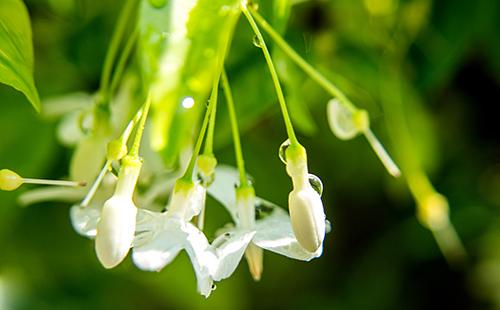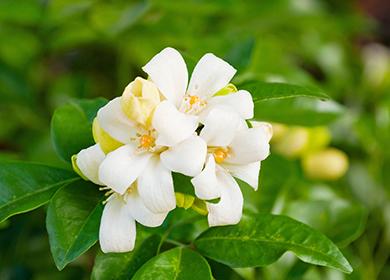The content of the article
The natural habitat of the plant is tropical forests. Indoor culture, which is also called the "imperial tree", "orange jasmine", is often used in alternative medicine, cooking. The ripe fruits of muraya are edible, healthy, even palatable.
Appearance and features of an exotic flower
Muraya is included in the root family. The genus includes evergreen shrubs and trees. Several varieties of culture are known, some of which are successfully grown as a houseplant. The root family is considered a direct relative of citrus crops. Murai berries are not only edible, but also contain beneficial substances.
The newly emerged pubescent shoots. With age, pubescence is lost. The leaves of muraya are unpaired, dark green, leathery, elliptical in shape. The leaves emit a pleasant smell.
Muraya flowers are small, white or pale cream, with a pronounced aroma. Some species are collected in inflorescences. Dried Muraya flowers - a medicinal or aromatic additive to teas. The fruits ripen for a long time - up to four months. The ripened fruits acquire a rich red color.
Popular Indoor Varieties
The genus is not numerous - it includes only eight varieties of muraya. Only two of the eight species take root in apartment conditions.
- Muraya Keniga. The plant is native to India. Individual specimens in the wild reach five meters. The leaves are medium-sized, cirrus. White flowers form quite large inflorescences, exude a strong, but not heavy aroma. After flowering, elongated, almost black fruits with a glossy skin ripen. This variety is difficult to grow.
- Muraya paniculata. Grows in the form of a tall shrub, sometimes reaches three meters in height. The leaves of the plant are long and narrow. Flowers are single or collected in dense inflorescences, exude a pronounced spicy aroma. Ripened fruits of red color, pleasant to taste. Full flowering begins not earlier than the fifth year of life. Compared with Muraya Koenig, is characterized by unpretentiousness.
Caring for muraya: creating a “tropical climate”
As for any tropical plant, for the "orange jasmine" create certain microclimate parameters - humidity, temperature, lighting. The rest of the plant is not capricious. How to take care of a muraya?
- Lighting. Muraya grows best in bright diffused lighting. On the south window they shade. It is not necessary to shade from the east and west - only in the hottest weather. In the summer, it is useful to take murayu to fresh air. On the balcony or in the garden for a potted plant, they find a place protected from wind, rain, direct sunlight.
- Temperature. In summer, muraya prefers moderate temperatures, about 20-25 ° C. In autumn, the temperature begins to gradually decrease, in winter it is brought to 17 ° C.
- Watering. This is a hygrophilous plant. If you forget to water Murayu, she will immediately lower the leaves. In summer they water abundantly and often, but stagnation of water in the root system is not allowed. By winter, the intensity of irrigation is reduced. Water the plant as necessary, taking into account the temperature of the content.
- Humidity. For murai create conditions of high humidity. Leaves need daily spraying with clean, warm, standing water. For hygienic purposes, wipe the leaves and shoots of muraya with a damp cloth. In late spring and summer, the plant is bathed once a week under a warm shower. In winter, the batteries are hung with a wet cloth. To maintain a constantly high level of humidity, the pot is placed on a tray with decorative pebbles, daily water is poured into it. The bottom of the pot should not come in contact with water.
- The soil. For muraya use loose soil. Acidity - neutral or slightly acidic. It is allowed to use store soil for citrus fruits with the addition of any baking powder - coconut fiber, coarse sand, vermiculite. The younger the plant, the higher the need for soil looseness. At home, the soil for muraya is prepared from deciduous land, turf, humus and coarse sand.
- Top dressing. Fertilizers are applied in the warm period - from March to September. Use complex mineral preparations. Feeding every two weeks. During flowering, you can feed organic fertilizers.
- Transfer. Transplanting muraya into another pot is performed as needed. Adult plants transship every three years, young ones need annual replacement of soil and pot. The reason for the unplanned transplantation of muraya is rotting of the roots, fungal diseases, the appearance of some pests, acidification of the soil. Caring for muraya after transplantation - moderate soil moisture, protection from the sun, drafts, pronounced temperature differences. Top dressing is suspended for a month.
Breeding methods
The seed and vegetative method of reproduction is used. The seed method is preferred - cuttings are slowly and poorly rooted.
Seeds
Growing muraya from seeds at home is considered the main method of reproduction. The only drawback is that muraya seeds quickly lose their germination capacity. The fresher they are, the higher the probability of their germination. The best option is to use seed from your plant. Take a bone from a fresh, well-ripened fruit. To obtain strong seedlings, murayas follow the following four-step sequence.
- Before planting, the seeds are soaked for a day in warm water. For fast germination, you can add a growth stimulator.
- It is better to plant seeds in peat tablets so as not to damage the root system during further transplantation. They are pre-soaked. In the center of each peat tablet is placed on the bone, deepened, slightly covered with peat.
- Peat tablets are at the bottom of a flat container, covered with a transparent lid or film. They put in a warm, sunlit place. Periodically, peat tablets are moistened, the greenhouse is aired every day, and condensate is removed.
- Depending on the temperature, the first shoots appear in one to two months. Shelter after germination is removed. At the stage of two or three real leaves, muraya seedlings can be planted in small pots directly in a tablet.
Cuttings
Propagation of muraya by cuttings is a more complicated method. They take root long and badly.Cuttings are cut with a margin - only part of them will give roots. The substrate is used light - a mixture of sand with peat. They operate according to the following four-step scheme.
- The apical cuttings from young, not lignified shoots of muraya are cut with a sharp knife. Leave on two pairs of leaves, cut them in half.
- The base of the handle is treated with the preparation “Heteroauxin” or another root formation stimulator. Planted in a sand-peat mixture at a slight angle.
- The soil is moistened, the cuttings are covered with plastic cups or a transparent film. Cuttings are kept warm. If possible, organize bottom heating. Moisturize regularly - drying out the earth is not allowed.
- Rooted cuttings of muraya are planted in separate pots. Large containers are not needed, just take pots with a diameter of 10-15 cm.
Common Growing Mistakes
Improper conditions of detention, missed irrigation, lack of drainage, and other inaccuracies in caring for muraia can lead to several problems. In adverse conditions, the plant's decorativeness decreases, yellowing of the leaves is observed, sometimes it even dies. The table will tell you what to fix so that muraya grows well and delights you with flowering.
Table - Errors in the care of muraia and their consequences
| Problem | Cause | Troubleshooting |
|---|---|---|
| Muraya leaves dry | - Sharp temperature changes; - high temperature and dry air in the room; - drying of the soil; - too voluminous pot | - Normalize the conditions of the muraya, adhere to the basic rules of care |
| Brownish spots appear on the leaves. | - Sunburn | - Hidden from the open sun |
| Muraya leaves fall | - Lack of light; - improper temperature | - Put Murayu in a more illuminated place; - normalize the conditions of detention |
| The bush is slowly growing | - Lack of nutrition; - stale air indoors; - dense soil; - too close a pot; - pest invasion | - Muraiu is regularly transplanted as the root system grows; - the room is systematically ventilated; - make balanced fertilizers according to the schedule |
| Murai leaves turn yellow | - Inadequate watering; - decay of the root system; - the appearance of pests on the leaves | - Regulate the watering mode; - they check the state of the root system, transplant muraya when it is damaged; - inspect for pests |
| Peduncles fall, the tips of the leaves dry | - dry air; - lack of moisture in the soil; - heat | - Spray the air around muraya; - increase humidity by any means |
| Muraya does not bloom | - Unsuitable pot size (too tight or too spacious); - lack of nutrients; - purchase of Dutch muraya (often not blooming) | - Murayu is transplanted into a pot of a suitable size; - regularly feed the plant with balanced fertilizer |
| Muraya leaves turn yellow, stain, veins remain green | - Chlorosis | - Sprayed with iron chelate |
| After flowering, fruits are not tied | - Long heat | - Murayu shade from the sun, try to avoid too high a temperature; - on hot days put in partial shade, often sprayed |

Pests and diseases
Muraya is quite resistant to pests.But inappropriate containment conditions sometimes still lead to insect attacks. Most often you have to deal with a spider mite. Its appearance and mass distribution provokes dry air. For more information on pests, see the table.
Table - Murai Pests
| Insect | Signs of defeat | Ways to fight |
|---|---|---|
| Spider mite | - Small bright spots appear on the leaves, which quickly turn into large bleached areas; - Muraya is covered with a thin web; - leaves turn yellow, dry, fall off | - Carry out pruning to remove heavily damaged shoots, remove dried leaves; - sprayed with the “Actellik” preparation, put a plastic bag on the plant for several hours; - the treatment is repeated at weekly intervals until the pests disappear completely |
| Shield | - Brown tubercles appear on the leaves and stems of murai; - the plant looks oppressed, slowly growing; - leaves turn pale and fall off | - The stalks of muraya are cleaned of pests mechanically; - places of mass accumulation of insects are wiped with alcohol or soapy water; - sprayed with drugs "Inta-vir", "Vermitek" |
| Aphid | - Young shoots of muraya are twisted, covered with sticky secretions of insects; - leaves turn yellow and fall | - Bathe murayu in the shower using a solution of laundry or potash soap; - spray the leaves with tobacco dust infusion or any preparation containing permethrin |
| Mealybug | - Lumps of white “cotton wool” form in the axils of the leaves of the muraya; - the stems, petioles and base of the leaves are covered with a whitish waxy coating; - leaves fall - the plant slows down growth | - Spray the plant with any systemic insecticide "Actellik", "Vermitek"; - treatment is carried out three times, with weekly interruptions |
Knowing how to care for muraya, you can achieve stable flowering and fruiting. The culture is considered unpretentious, but sensitively reacts to inappropriate conditions of detention. Muraya is a long-lived plant. With proper care, the abundance of flowering will only increase every year.

